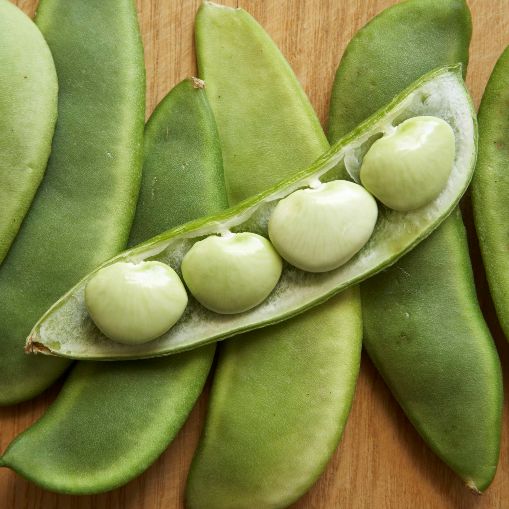Controversial on the table, yet fairly straightforward in the garden – lima beans don’t do much to earn such a bad reputation. Divided into two types, lima and butter, these beans have historically been grown in the Americas and are nutritional powerhouses that actually complement a variety of meals.

Lima type beans can be roughly divided into small and large varieties. Particularly in the Southern United States, one will find the smaller, greener, sieva types called lima beans, while the larger Fordhook type beans are often referred to as butter beans. These beans are well regarded as being easy to grow and delicious once harvested. The debate quietly seethes about exact terminology, but most that’ve eaten butter beans recognize their creamy and delicious taste.
Growing limas and butter beans is similar to growing most other bean plants. Some varieties vine and can be trellised or trained to poles, while others are bush beans. Bush types include Henderson’s Bush Lima, Wood’s Prolific Lima and the Fordhook 242 Bush Lima. Carolina Lima, Southern Pole Butterbean, King of the Garden Lima and Willow Leaf are all pole types. Bush types tend to mature more quickly than vining types, but require more room per plant. These varieties all feature different resistances, but most are heat tolerant and all prefer warmer temperatures.
As with most other beans, butter and lima beans prefer moist, fertile soil, and plenty of light. Heat and water stress will make plants and beans woody, stringy, and tough. Lima and butter beans should be planted a little shallower than other bean varieties – no deeper than one inch in light soil and less in heavy soil. Soil temperature matters to beans; early planting in cold soil (below 50 F), particularly with untreated organic or heirloom types is an invitation to rot or poor germination. Harvest beans when the pods look plump and the bumps of beans inside the pods can be felt. Pods should be a bright green color at harvest. To harvest for dry beans, leave the pods on the plants until the pods are dry, brittle, and snap open easily. However, if you plan on freezing them or there is a wetter than normal weather forecast, it’s better to harvest the pods early and allow them to finish drying in a protected space.
Dried lima and butter beans should be stored in an airtight container. Freshly shelled beans are best if they are cooked right away, but can be stored in the refrigerator in a resealable bag or other container for about a week. Frozen beans can be put away for later use, and storing homegrown beans offers a distinct flavor advantage to mass produced beans. Lima and butter beans that are to be frozen must be washed and shelled. Blanch the shelled beans in boiling water; from 2 and 4 minutes, depending on the size of the beans. If you have a large number of beans to blanch, it is best to boil them off in batches, rather than trying to do them all at once. After this brief boil, plunge the beans into a bowl or basin filled with ice water. Once the beans have cooled completely, remove them from the cold water and drain. At this point, the beans can be placed all together in a labeled freezer bag and frozen, or they can be spread on a pan in a single layer, frozen and then placed in a freezer container. The second method is advantageous if the beans will need to be measured for use in a recipe as the beans freeze individually, rather than in a large mass.
There are many dishes that include limas and butter beans, and many other dishes could be modified to include them. A midwinter bean and pasta soup could be enriched with their addition, and some cooks make a puree of lima beans to use instead of milk or cream in soups. Cooks across the county boil them with a ham bone and a little sausage and sautéed onions for comfort food that tastes delicious with corn muffins. Butter beans in a rich olive oil, garnished with a hit of fresh parsley, minced garlic and lemon juice are delicious as a side salad or included on a garden salad.
The classic preparation in the South, however, is succotash, which makes use of complementary tomatoes and corn, and is best when all ingredients are fresh. Okra can be included, and this dish can be served with or without cream, according to one’s dietary requirements.
Succotash
1/2 cup butter
1 sweet onion diced (A 1015, Vidalia or Walla Walla would be delicious)
2 cups fresh butter or lima beans clean and dried
1/2 cup butter
4 fresh tomatoes, peeled and chopped
4 ears fresh corn kernels cut from the cob
2 teaspoons white sugar (to taste)
1/2 teaspoon salt (to taste)
Up to 1/2 cup heavy cream, if desired for taste and texture
Melt 1/2 cup butter in large saucepan over low medium heat. Add onion and cook until the onion has started to become translucent. Add beans, and cook until tender, about 15 minutes. In a separate pan, heat 1/2 cup butter, add the tomatoes, and cook until tender, about 15 minutes. Stir the tomatoes into beans and onions, add cream if desired and cook for about 10 more minutes. Check for flavor and add seasonings as needed. Serves about 6.
Amy Ambrosius is a writer and budding gardener living deep in the heart of Texas with her family.
Related Articles & Free Email Newsletter
Preventing Late Blight in Tomatoes & Potatoes




Comment here